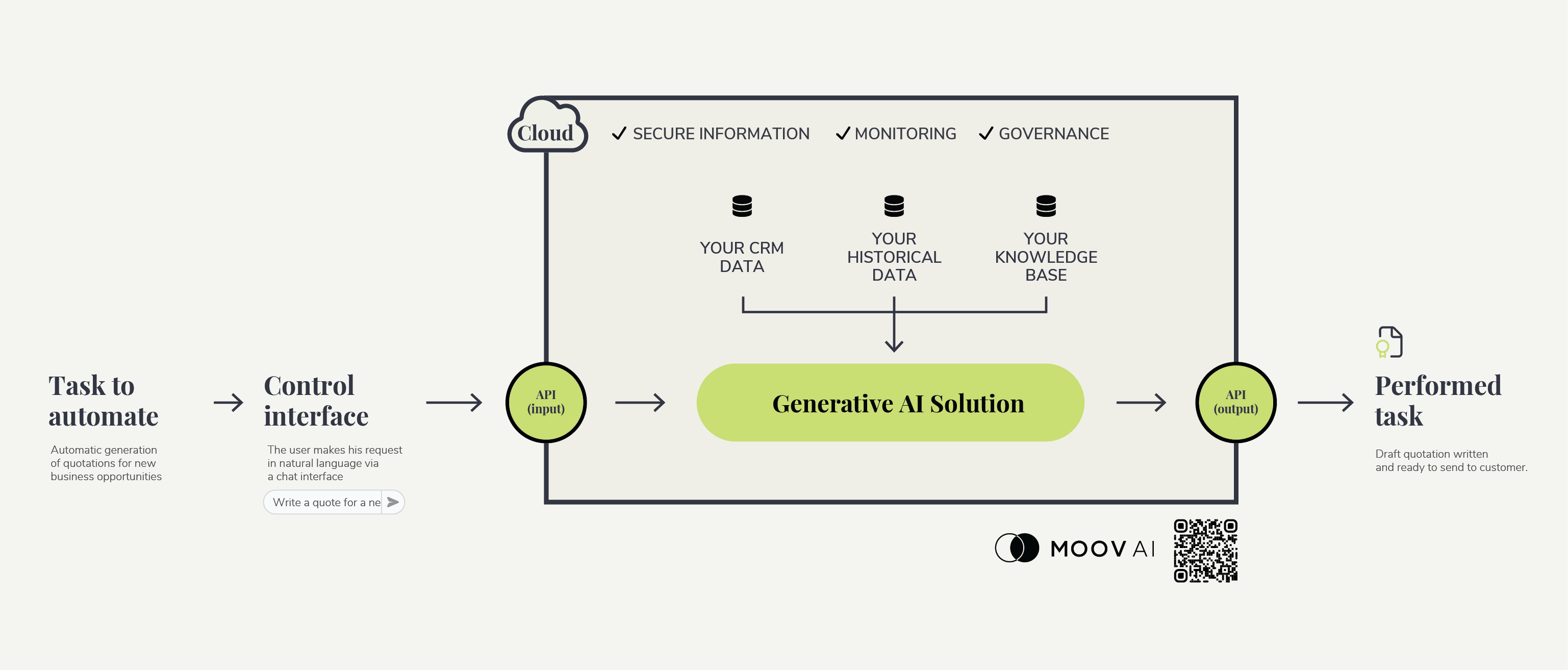The challenges of integrating innovation like generative artificial intelligence solutions in your company
OpenAI made a big impact in the field of artificial intelligence by unveiling ChatGPT, sparking a frenzy of adoption among millions of people. For the first time, we witnessed a true democratization of artificial intelligence. This innovation opened the eyes of everyday individuals and the business world to new possibilities. Generative AI enables everyone to explore the capabilities of this advanced technology almost instantly.
Following OpenAI’s success, other companies such as Google (Gemini), Anthropic (Claude), and Meta (LLaMa) also released their large language models (LLMs) to compete with OpenAI (ChatGPT, GPT-4). These solutions are all powerful generative AI tools that can generate precise and rich responses from prompts.
However, the rapid success of these LLMs raises several risks, including societal and reputational concerns. Questions have also been raised about their integration in a professional context. This brings us to a well-known concept in business: innovation management. It’s not just about using new technology for the sake of it, but rather implementing it with a specific goal to achieve a competitive advantage. Like any other AI solution, considering the adoption of generative AI must begin with the business objectives you have set.
The challenges lie in innovating with generative AI, deploying it at scale, integrating it into the current company system, and managing the associated risks. When a solution arrives on the market so abruptly, it is essential to understand it thoroughly before adopting it too quickly and potentially having to backtrack.
Thus, companies quickly face the limitations and potential risks of generative AI. Let’s be clear: using the free version to automate business processes is a bad idea. Despite its performance and opportunities, this tool is not a B2B solution. This raises the question: how can we extend these capabilities to our professional activities more appropriately while mitigating the risks?
Thankfully, there are solutions specifically designed for enterprise use and offering business capabilities. B2B tools provided by Google, Microsoft, and AWS cater to the specific needs of businesses, allowing them to fully leverage the benefits of generative AI while ensuring optimal security and efficiency.
Risks and limitations of generative AI
Before delving into the topic, let us explain why no company should use the public version of ChatGPT (or other similar tools) to blindly automate critical processes within their business.
Data security
Data security is a major concern when using public platforms like Gemini and ChatGPT. It is crucial to adopt preventive measures now to avoid sharing sensitive information through these tools.
By default, the data input into these tools creates a security breach as it goes to a third-party server. This information is transmitted to the servers of the company that created these solutions. All information provided via prompts to ChatGPT, for example, can be used by OpenAI.
Now, this is not for the purpose of “stealing information to dominate the world.” Instead, it’s to deepen the understanding of use cases and improve the technology. However, it is essential to recognize the potential risk this poses to the security of our company’s information. There are already examples of misusing ChatGPT, like the former Samsung employee who used it to optimize his code, inadvertently sharing sensitive company information with OpenAI’s servers. This represents an internal information breach.
Therefore, it is highly recommended to exercise caution and not share sensitive information that could compromise data confidentiality and security when using OpenAI’s APIs.
ChatGPT is trained until 2021
It’s also important to note that ChatGPT was trained until September 2021, which means its knowledge and capabilities may not be up-to-date with the latest information. This applies to all other LLMs trained on past data as well. For example, if you ask a generative AI solution about the latest financial statements of Shopify, you might get outdated information. This highlights the importance of understanding the temporal limitations of generative AI solutions and not considering their responses as up-to-date information in all respects. If you want recent information, it’s essential to include the most recent data in your query and base the response on that information.
Hallucinations
Chatbot responses can be useful, humorous, or, in some cases, outright invented. Grand language models can sometimes hallucinate. Hallucination here refers to false information in the generated text that may seem plausible but is actually incorrect. With generative AI text solutions, the responses are delivered with such confidence that they can easily mislead. If you want to write a poem about haystacks using ChatGPT for entertainment purposes, the impact of a potential hallucination is minimal. However, in a professional environment, where you consult information to make critical decisions, data accuracy is paramount.
When using generative AI solutions’ query prompts without providing sufficient context, you receive the most statistically plausible response, but the LLM may misinterpret it due to a lack of context surrounding the request. This puts you at risk of receiving a response that seems appropriate but might contain false information. It is our responsibility to validate the generated information to ensure accuracy before publishing it, to avoid unintentionally creating “fake news.”
In short, we cannot fully trust what the machine regurgitates, and that is problematic in a business context.
Series on generative artificial intelligence
This article is part of a series we have produced to help businesses better understand generative AI and its possibilities.
- Solutions for SAP, Oracle, and Microsoft Dynamics Inventories
- The Essential Use Cases of Generative Artificial Intelligence
- How to leverage generative artificial intelligence solutions in business without drifting [Conference on demand]
Generative AI solutions adapted for enterprises
As mentioned earlier, ChatGPT is more of a B2C tool and comes with risks concerning the security of business information.
Thankfully, there are now tools specifically designed for enterprises provided by Google, Microsoft and AWS. These tools are recommended for professional use.
For example, Google Cloud’s suite now includes several tools such as Generative AI App Builder, Duet AI for Google Workspace , and generative AI support on Vertex. With these, you have the robust and secure structure of Google for your business projects.
Security is reinforced as the content remains within a secure and private shell, ensuring that the information transmitted to the model will not be stored publicly. You can also apply your data governance plan to comply with your internal security processes, which is much more reassuring.
Creating your own generative AI solution in-house
An interesting practice with professional generative AI versions is the possibility for a company to integrate its own technical documents and create an in-house solution by defining specific limits and parameters. This approach allows for developing a personalized virtual assistant accessible to all members of the company, offering easy access to internal knowledge bases. This initiative encourages collaboration and simplifies the dissemination of information within the organization, thereby enhancing overall efficiency and productivity. By customizing generative AI to meet the company’s needs, you can maximize the benefits of this technology while adhering to the organization’s specific policies and requirements. Both Google and Microsoft allow you to create a company-specific interface and offer a secure generative AI solution that considers the organization’s specific parameters.
This practical example provides an opportunity to embark on a generative AI project that offers great value while presenting low risks.
Validating before using
How do you estimate if generative AI performs well in solving your problem? It’s simple; just measure the success rate over 50-100 similar queries. This will help estimate the potential success when using the solution in a normal context and give you more confidence.
It’s super powerful to be able to create query templates or a process once certain tasks have been validated by users. This way, you can generate a platform that can act as a more generalist personal assistant while automating or optimizing specific tasks. Project teams are encouraged to stay alert for tasks that bring the most value and try to generate these templates or processes to make them accessible to all users.
An overview of a generative AI solution

Let’s consider a company that wants to automate the automatic writing of submissions to address new business opportunities.
Task to automate: Automatic writing of submissions based on customer data from your CRM, historical submission data from the past, and various knowledge bases such as internal documentation, customer exchanges, or other data.
Query interface: A software interface integrated with your existing tools (Teams, Slack, Salesforce, etc.) that allows your users to write queries in natural language that activate the generative AI solution. For example: “Write a submission for our new client Olivier from Moov AI company for a proof of concept to automate submissions for a particular project using generative AI.”
API (input and output): API stands for “Application Programming Interface.” An API defines the methods and data formats that developers can use to access the functionalities of software, platforms, or third-party services. These two APIs facilitate information exchange and integration between your systems and the generative AI solution.
Data: The generative AI solution will have been previously personalized with your data. Think of generative AI tools as empty shells into which you can integrate your data and leverage the same response power as open solutions. The response of the generative AI solution will be based on your data.
This data can include your CRM data, customer email exchanges, knowledge base, documentation, past submissions, project reports, actual project costs, etc. Anything relevant and written can be integrated into these solutions.
Professional cloud platform: These solutions no longer need an introduction. Unlike solutions offered to the general public like ChatGPT, cloud solutions offer increased data security, the possibility to apply your data governance plan, and monitoring capabilities for your environments, data, and models. Your data and the various commands you issue will remain in your secure Cloud environment, safe from external eyes.
Generative AI solution and task executed: Your query will be processed by the generative AI solution using your data and your company as context. The result will be, for example, the drafting of a new submission tailored to your service offering and the specific needs of the client you just targeted. This draft submission will be complete and ready for review by a human colleague who will send it to the client. All of this in just a few minutes.
Good tools for good work
The launch of ChatGPT by OpenAI has opened exciting new perspectives in the field of artificial intelligence. The democratization of this advanced technology has allowed millions of users to explore its capabilities almost instantly. However, it is essential to consider the risks and limitations associated with using these LLMs. Using generative AI tools for business is significant for safe professional use.
Ultimately, by understanding the risks and using these technologies judiciously, we can leverage their full potential while ensuring the security and protection of sensitive data. Artificial intelligence continues to evolve, and it is important to adopt a balanced and thoughtful approach in its use to make the most of it.

Olivier is co-founder and VP of decision science at Moov AI. He is the editor of the international ISO standard that defines the quality of artificial intelligence systems, where he leads a team of 50 AI professionals from around the world. His cutting-edge AI and machine learning knowledge have led him to implement a data culture in various industries.